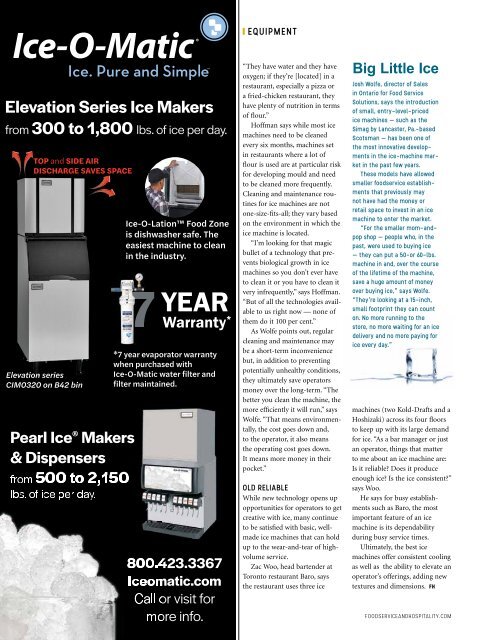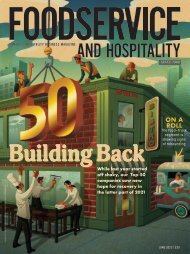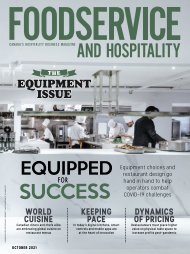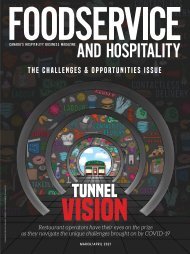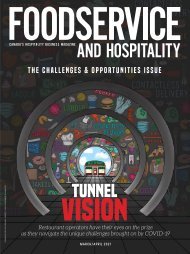FH0320
Create successful ePaper yourself
Turn your PDF publications into a flip-book with our unique Google optimized e-Paper software.
EQUIPMENT<br />
“They have water and they have<br />
oxygen; if they’re [located] in a<br />
restaurant, especially a pizza or<br />
a fried-chicken restaurant, they<br />
have plenty of nutrition in terms<br />
of flour.”<br />
Hoffman says while most ice<br />
machines need to be cleaned<br />
every six months, machines set<br />
in restaurants where a lot of<br />
flour is used are at particular risk<br />
for developing mould and need<br />
to be cleaned more frequently.<br />
Cleaning and maintenance routines<br />
for ice machines are not<br />
one-size-fits-all; they vary based<br />
on the environment in which the<br />
ice machine is located.<br />
“I’m looking for that magic<br />
bullet of a technology that prevents<br />
biological growth in ice<br />
machines so you don’t ever have<br />
to clean it or you have to clean it<br />
very infrequently,” says Hoffman.<br />
“But of all the technologies available<br />
to us right now — none of<br />
them do it 100 per cent.”<br />
As Wolfe points out, regular<br />
cleaning and maintenance may<br />
be a short-term inconvenience<br />
but, in addition to preventing<br />
potentially unhealthy conditions,<br />
they ultimately save operators<br />
money over the long-term. “The<br />
better you clean the machine, the<br />
more efficiently it will run,” says<br />
Wolfe. “That means environmentally,<br />
the cost goes down and,<br />
to the operator, it also means<br />
the operating cost goes down.<br />
It means more money in their<br />
pocket.”<br />
OLD RELIABLE<br />
While new technology opens up<br />
opportunities for operators to get<br />
creative with ice, many continue<br />
to be satisfied with basic, wellmade<br />
ice machines that can hold<br />
up to the wear-and-tear of highvolume<br />
service.<br />
Zac Woo, head bartender at<br />
Toronto restaurant Baro, says<br />
the restaurant uses three ice<br />
Big Little Ice<br />
Josh Wolfe, director of Sales<br />
in Ontario for Food Service<br />
Solutions, says the introduction<br />
of small, entry-level-priced<br />
ice machines — such as the<br />
Simag by Lancaster, Pa.-based<br />
Scotsman — has been one of<br />
the most innovative developments<br />
in the ice-machine market<br />
in the past few years.<br />
These models have allowed<br />
smaller foodservice establishments<br />
that previously may<br />
not have had the money or<br />
retail space to invest in an ice<br />
machine to enter the market.<br />
“For the smaller mom-andpop<br />
shop — people who, in the<br />
past, were used to buying ice<br />
— they can put a 50-or 60-lbs.<br />
machine in and, over the course<br />
of the lifetime of the machine,<br />
save a huge amount of money<br />
over buying ice,” says Wolfe.<br />
“They’re looking at a 15-inch,<br />
small footprint they can count<br />
on. No more running to the<br />
store, no more waiting for an ice<br />
delivery and no more paying for<br />
ice every day.”<br />
machines (two Kold-Drafts and a<br />
Hoshizaki) across its four floors<br />
to keep up with its large demand<br />
for ice. “As a bar manager or just<br />
an operator, things that matter<br />
to me about an ice machine are:<br />
Is it reliable? Does it produce<br />
enough ice? Is the ice consistent?”<br />
says Woo.<br />
He says for busy establishments<br />
such as Baro, the most<br />
important feature of an ice<br />
machine is its dependability<br />
during busy service times.<br />
Ultimately, the best ice<br />
machines offer consistent cooling<br />
as well as the ability to elevate an<br />
operator’s offerings, adding new<br />
textures and dimensions. FH<br />
FOODSERVICEANDHOSPITALITY.COM


